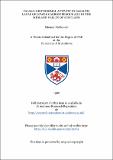Palaeo-geothermal activity in basaltic lavas of Lower Carboniferous age in the Midland Valley of Scotland
Abstract
Post-extrusive hydrothermal alteration within basaltic lavas has been examined with special reference to the Lower Carboniferous Clyde Plateau Basalts of the Midland Valley of Scotland. Within this province several steep-sided, narrowly constrained zones of intense water-rock interaction have been located and examined. It is thought that these zones, or metadomains, developed where hydrothermal fluids exploited permeability contrasts within the volcanic pile and as such they represent foci for geothermal fluids which advected through the lavas. In the field metadomains are often manifest as areas of intense alteration and hydrofracting of the host basalts. Characteristic alteration mineralogies are often hydrous and typically include evolved phyllosilicate assemblages, prehnite, analcime and calcite. Petrography reveals that prehnite and analcime are always paragentetically earlier than calcite across the whole of the lavas. Also, metadomain development was accompanied by significant elemental mobility within the host basalts; Si, Ti, Fe, Mn, Mg, Ca, Na and K all exhibit varying degrees of mobility, whilst Sr, Rb, Cu and Zn display extreme mobility. Furthermore, metadomain basalts have higher volatile contents than there unaltered counterparts. Fluids present during metadomain development typically were Ca2+, Na+, Cl- dominated brines which exhibited both a wide range in salinity (approximately 0 to 25 equiv. wt. % NaCI) and temperatures (approximately 50°C to 300°C). As the development of metadomains proceeded it appears that the fluid present was a hybrid formed from the interaction and mixing of a low temperature, low salinity fluid which was ultimately of surface origin and a higher temperature brine derived from the underlying sediments. The presence of minor amounts of hydrocarbon material within the fluids testified to the involvement of organic rich sequences within the underlying Inverclyde Group sediments. These fluids also record a number of physical processes which are observed within currently active geothermal systems such as mixing and boiling indicative of near surface conditions. Such processes appeared to be largely responsible for controlling the gas content of the fluids. Combined fluid inclusion and stable isotopic analysis of alteration phases (specifically analcime and calcite) has been used to determine fluid origins and evolution during metadomain development. Fluids present during the precipitation of analcime appears to have originated as a surface derived fluid which interacted (isotopically and chemically) with reactive, carbonate rich sediments, possibly the underlying Inverclyde Group. Fluids present during calcite precipitation can be separated into two distinct groups; a low to intermediate (c. 90 to 200°C) surface derived fluid and a higher temperature fluid which also appears to have interacted with reactive sediments. Carbon isotopic results confirm that organic derived material interacted with these fluids. Uniformity in carbon isotopic compositions suggests that the carbon reservoir was active prior to calcite precipitation. As geothermal activity waned calcite precipitation still continued whilst fluid temperatures decreased due to convective cooling of the lava pile. During this stage it appears that fluids were dominantly of surficial origin.
Type
Thesis, PhD Doctor of Philosophy
Collections
Items in the St Andrews Research Repository are protected by copyright, with all rights reserved, unless otherwise indicated.

